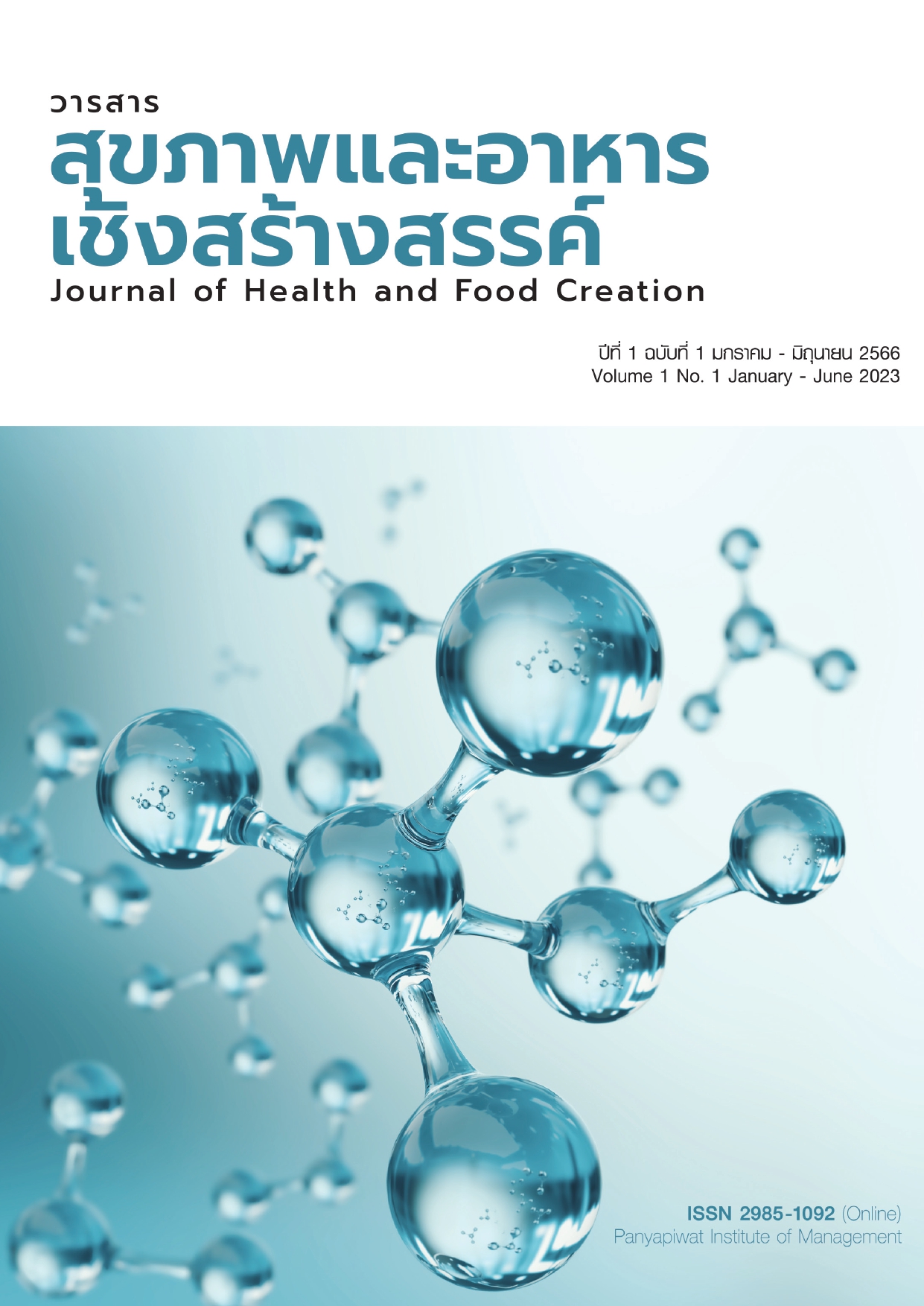DEVELOPMENT OF READY-TO-DRINK YOGURT PRODUCTS FROM BUFFALO MILK
Keywords:
Buffalo Milk, Drinking Yogurt, Sensory Evaluation, Shelf LifeAbstract
In this research, ready-to-drink yogurt products were developed from buffalo milk
because they were popular among consumers and had a potential to be commercially produced. Murrah buffalo milk was brought from the farm that raised them in accordance with GAP standards in order to analyze its chemical and physical properties. Then yogurt was fermented using 10% (w/w) of commercial strains which were Lactobacillus bulgaricus and Streptococcus thermophiles. Then, the milk was incubated at 45 ํC for 8 hours until the curd was formed and the pH of the curd reached 4.44. Three flavors of ready-to-drink yogurt products including original flavor, orange flavor and strawberry flavor were produced. The pH and total soluble solid of the flavored drinking yogurt were around 3.88-3.98 and 17-19 ํBrix, respectively. The sensory acceptability was evaluated. The result showed that the highest consumer acceptance score was drinking yogurt with strawberry flavor (p < 0.05). Then, the shelf life evaluation of the strawberry flavored drinking yogurt was studied. The result revealed that the shelf-life of strawberry flavored drinking yogurt was 9 days when kept at 4 °C. The microbiological quality (Lactic acid bacteria, Mold, and Yeast) of the product comply with the standard quality of drinking yogurt products based on the Notification of the Ministry of Public Health’s Announcement, No. 353 (2013).
References
Chaikulsareewath, A. (2012). Production of drinking yogurt fortified with gac fruit. Journal of Food Technology Siam University, 7(1), 23-30. [in Thai]
Chaikulsareewath, A. Chauykaew, W., & Sakulsong, N. (2015). Flavor quality improvement of homnin brown rice yoghurt. Agricultural Science Journal, 46(3)(Suppl.), 709-712. [in Thai]
Food industry intelligent center (FIC-NFI). (2017). Market overview of milk and yogurt product in Thailand. http://fic.nfi.or.th/MarketOverviewDomesticDetail.php?id=146
Guimarães, D. H. P., & Silva, F. R. S. R. (2014). Dairy products production with buffalo milk. International Journal of Applied Science and Technology, 4(3), 14-19.
Horwitz, W. (2000). Official Methods of Analysis of AOAC International (17th ed.). AOAC International Gaithersburg, Md.
Klabkong, K., Kwanmuang, P., & Bunnak, J. (2015). Isolation of lactic acid bacteria from Murrah buffalo’s milks and the potential of yogurt fermentation. In The 53rd Kasetsart University Annual Conference: Science, Genetic Engineering, Architecture and Engineering, Agro-Industry, Natural Resources and Environment (pp. 873-880). https://kukrdb.lib.ku.ac.th/proceedings/KUCON [in Thai]
Krusong, W. & Pongsawasmanit, R. (1995). Fermentation technology in Industry. SE-ED publisher.
Lee, W. J., & Lucey, J. A. (2010). Formation and physical properties of yogurt. The Asian Australasian Association of Animal Product Societies, 23(9), 1127-1136.
Martin-Diana, A. B., Janer, C., Plaez, C., & Requena, T. (2003). Development of a fermented goat’ milk containing probiotic bacteria. International Dairy Journal, 13(10), 827-833.
Ministry of Public Health. (2013). Notification of the Ministry of Public Health (no. 353) B. E. 2556 regarding to fermented milk. https://faolex.fao.org/docs/pdf/tha159846.pdf
National Bureau of Agricultural Commodity and Food Standards (ACFS). (2021). Agricultural product standards no. 6007-2564 regarding to raw buffalo milk. http://sutlib2.sut.ac.th/ebook/H175980.pdf
Ngokngam, P., & Nakthong, S. (2013). Buffalo milk benefits. Kasetsart Extension Journal, 39(156), 48-53. [in Thai]
Osiripan, W. (2015). Goat milk drinking yogurt development. Ramkhamhaeng Research Journal Sciences and Technology, 18(1), 1-8. [in Thai]
Pobpad. (2022). Fermented milk, a drink with many benefits easy to drink. https://www.pobpad.com/นมเปรี้ยว-เครื่องดื่มมา [in Thai]
Sanghuayprai, N. (2011, July 15). Milkability, milk chemicophysical properties of native buffalo and milk buffalo. Group of buffalo research and development. Department of Livestock Development. http://www.dld.go.th/breeding/buffalo.pdf [in Thai]
Saribood, W., Oupathumpanont, O., & Kanchana, R. (2013). Development of yogurt product from Murrah milk (Abstract). https://research.rmutt.ac.th/2014/09/03/การพัฒนาผลิตภัณฑ์โยเกิ/ [in Thai]
Stone, H. (2012). Sensory evaluation practices (4th ed.). Elsevier/Academic Press.
Tangtaweewipat, S. (2015). Milk buffalo village. www.clinictech.ops.go.th/online/pages/scivillage_view.asp?vid=443 [in Thai]
Taweerattanon, N. (2015). Yogurt. UTK Research Journal, 9(1), 40-44. [in Thai]
Thai Industrial Standards Institute (TISI). (2004). Thai industrial standard number 2146-2546 regarding to fermented milk. http://www.fio.co.th/WeB/tisi_fio/fulltext/TIS2146-2546.pdf [in Thai]
Vadhanasin, S. (2002). Food microbiology. Kasetsart University Publisher. [in Thai]
Zawa, M. A., & Sansinena, M. (2017). Buffalo milk characteristics and by-products. https://core.ac.uk/download/158328609.pdf
Downloads
Published
Issue
Section
License
Copyright (c) 2023 Journal of Health and Food Creation

This work is licensed under a Creative Commons Attribution-NonCommercial-NoDerivatives 4.0 International License.
“ข้าพเจ้าและผู้เขียนร่วม (ถ้ามี) ขอรับรองว่า บทความที่เสนอมานี้ยังไม่เคยได้รับการตีพิมพ์และไม่ได้อยู่ระหว่างกระบวนการพิจารณาลงตีพิมพ์ในวารสารหรือแหล่งเผยแพร่อื่นใด ข้าพเจ้าและผู้เขียนร่วมยอมรับหลักเกณฑ์การพิจารณาต้นฉบับ ทั้งยินยอมให้กองบรรณาธิการมีสิทธิ์พิจารณาและตรวจแก้ต้นฉบับได้ตามที่เห็นสมควร พร้อมนี้ขอมอบลิขสิทธิ์บทความที่ได้รับการตีพิมพ์ให้แก่สถาบันการจัดการปัญญาภิวัฒน์หากมีการฟ้องร้องเรื่องการละเมิดลิขสิทธิ์เกี่ยวกับภาพ กราฟ ข้อความส่วนใดส่วนหนึ่งและ/หรือข้อคิดเห็นที่ปรากฏในบทความข้าพเจ้าและผู้เขียนร่วมยินยอมรับผิดชอบแต่เพียงฝ่ายเดียว”





